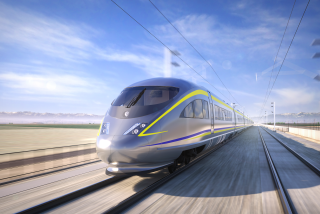Tracking the Up-Down Fortunes of Funiculars
JOHNSTOWN, Pa. — Its official name is the Johnstown Inclined Plane, but residents here call it the Heavenly Hoist.
The Inclined railway’s two cars whiz up and down the steep 896.5-foot, 72%-grade Yoder Hill 65 times a day, one trip every 15 minutes. It’s fast, smooth, quiet like an elevator going at a slant. Ninety seconds, and it’s all over.
Regular commuters living in the hillside residential community of Westmont ride the Inclined Plane to work and school every day. Others take the railway to Johnstown to shop, eat out, or go to a movie.
At least 30 automobiles ($1.50 each way for the car and $1 for each passenger) are carried daily in the 15-foot wide, 34-foot long rail cars that transport as many as 50 passengers a trip. The rail cars stand straight out in the air in a most peculiar manner above the steep tracks as they go up and down the mountain.
Until the 1950s buses were also carried on the rail cars, but modern buses are too large. So, many commuters transfer from Westmont buses to the Inclined Plane and back again to buses at the Lower Station in Johnstown.
There are about a dozen quaint funiculars providing public transportation up and down steep slopes in various places in the United States. The Heavenly Hoist is one of three Incline railways operating in Pennsylvania--the other two are in Pittsburgh.
During the earlier part of the century there were more than 200 Incline railways from Maine to California. In Downtown Los Angeles, for example, there were two separate Incline railways. The 325-foot-long Angel’s Flight operated on Bunker Hill from 1901 to 1969, and the 180-foot-long Court Flight from 1904 to 1942. For the past 20 years, Angel’s Flight has sat dismantled and gathering dust in storage waiting to be restored and put back into service.
This has been one of the busiest years in recent memory for the Johnstown Inclined Plane. By the end of the year more than 500,000 passengers will have ridden the electrically powered, counterbalanced cable car system, the vast majority attending the centennial events commemorating the Johnstown Flood.
On May 31, 1889, South Fork Dam suddenly gave way, sending a 70-foot avalanche of water through the steel mill town. The Johnstown Flood killed more than 2,200 men, women and children and left an incredible path of destruction.
In the aftermath of the Great Flood, the Cambria Iron Co., which was one of the largest steel producers in America, with 7,000 Johnstown men on its payroll, erected a model community on 1,000 acres of farm land it owned on top of Yoder Hill.
It constructed the Incline railway to provide transportation from the new hilltop community of Westmont to its Johnstown mines and mills. The Incline railway began operating June 1, 1891.
Between 1900 and 1920, the railway ran around the clock seven days a week with a trip every five minutes. The fare was a penny a ride. Today the fare is $1. In 1919, the peak year, 1,356,293 passengers rode the Incline. When flood waters inundated Johnstown again in 1936 and 1977, the railway carried thousands of people to higher ground and safety.
Steel companies operated the Incline railway until 1923 when it was sold to the borough of Westmont for $1. The municipality ran it until 1982. It was sold again for $1, this time to the Cambria County Transit Authority which has run it ever since as a vital link in Johnstown’s mass transit system.
The Johnstown Inclined Plane has been in service continuously for 98 years except for an 18-month hiatus starting in January, 1983, when $3.5 million of federal, state and local funds were used to rehabilitate the roadbed, tracks, equipment, rail cars and stations.
Pittsburgh was once America’s Incline railway capital. It had 17 of the quaint railways, more than any other city in the nation, but only two have survived, the Monongahela and the Duquesne (Du-cain.)
The Monongahela Incline, the first passenger Incline railway in America, is still in service carrying over 2,000 commuters each day from the top of Washington Hill to Downtown Pittsburgh.
Among the Incline railways that fell by the wayside were the Mt. Oliver, Penn, Troy Hill, Castle Shannon and Nunnery Hill. Knoxville Incline, which operated from 1890 to 1960, had an unusual curved track.
The Duquesne was shut down in 1962 and preparations were made to dismantle it when residents of Duquesne Heights formed the Society for the Preservation of the Duquesne Heights Incline. They conducted a series of fund-raisers to save the old railway.
The Duquesne’s fare is 75 cents each way for the 793-foot ride along a 58.5% grade.
Pennsylvania’s three Incline railways--the Johnstown Inclined Plane, the Monongahela Incline and the Duquesne Incline--are relics of the past which provide a service just as important today as when they were originally constructed in the 19th Century.
More to Read
Sign up for The Wild
We’ll help you find the best places to hike, bike and run, as well as the perfect silent spots for meditation and yoga.
You may occasionally receive promotional content from the Los Angeles Times.






